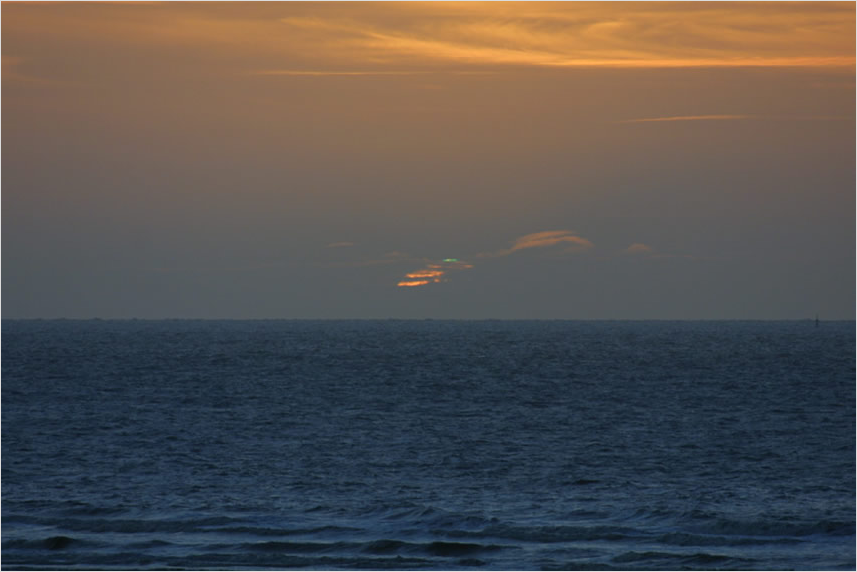Green flash over the North Sea
Green Flash over the North Sea: A Spectacular Atmospheric Phenomenon
The North Sea is known for its breathtaking beauty and stunning sunsets. But have you ever heard of the "green flash" that occasionally occurs over the North Sea? This rare atmospheric phenomenon has captivated photographers and skywatchers alike. In this article, we will delve into the fascinating world of the green flash and explore the unique circumstances that give rise to this awe-inspiring spectacle.
What is the Green Flash?
The green flash is a phenomenon that occurs during sunrise or sunset when a brief flash of green light appears just above the sun's disk. It is a result of atmospheric refraction, where the Earth's atmosphere bends the sunlight as it passes through. This bending causes different colors of light to separate, with shorter wavelengths, such as blue and green, being refracted more than longer wavelengths, like red and orange.
The Science Behind the Green Flash
To understand the green flash, we need to delve into the science behind it. As the sun sets or rises, its light passes through a greater thickness of the Earth's atmosphere. This increased atmospheric density causes the sunlight to undergo more refraction, leading to the separation of colors. The green flash occurs when the conditions are just right for this separation to become visible to the naked eye.
Types of Green Flash
There are different types of green flashes, each with its own unique characteristics. One type is known as the "M-Mir" flash, which is generated by an inversion layer above the photographer and curved by vertical waves in the atmosphere. This type of flash appears high above the horizon and can last for several minutes, creating a mesmerizing display of green light.
Another type of green flash is called the "I-Mir" flash. This type occurs when there is an inversion layer near the horizon, causing a mirage-like effect that enhances the visibility of the green flash. I-Mir flashes are typically shorter in duration compared to M-Mir flashes but are equally enchanting to witness.
The Role of Atmospheric Conditions
The occurrence of the green flash is heavily influenced by atmospheric conditions. One crucial factor is temperature inversion, where a layer of warm air lies above a layer of cooler air. This inversion layer acts as a lens, bending the light and creating the conditions necessary for the green flash to manifest.
Vertical waves in the atmosphere also play a significant role in shaping the green flash. These waves, often caused by variations in wind speed and direction, can curve the light as it passes through the atmosphere, intensifying the separation of colors and enhancing the visibility of the green flash.
Capturing the Green Flash
Photographers and sky enthusiasts often strive to capture the elusive green flash in all its glory. However, capturing this phenomenon requires patience, skill, and a bit of luck. Timing is crucial, as the green flash only lasts for a fleeting moment. Additionally, having a clear view of the horizon and favorable atmospheric conditions can greatly increase the chances of witnessing and photographing this stunning event.
Beyond the North Sea
While the North Sea is renowned for its stunning green flashes, this phenomenon can occur in other parts of the world as well. Coastal regions with clear skies and favorable atmospheric conditions are ideal for observing the green flash. Popular locations for witnessing this spectacle include coastal areas along the Pacific Ocean, such as California and Hawaii, as well as other oceanic regions with unobstructed views of the horizon.
Exploring Atmospheric Optics
The green flash is just one example of the many fascinating atmospheric optical phenomena that occur around the world. From rainbows and halos to mirages and auroras, our atmosphere never ceases to amaze us with its ability to bend and manipulate light. Exploring these phenomena not only deepens our understanding of the natural world but also allows us to appreciate the beauty and complexity of our atmosphere.
Conclusion
The green flash over the North Sea is a captivating atmospheric phenomenon that enchants all who have the privilege of witnessing it. This fleeting burst of green light, caused by atmospheric refraction and favorable conditions, adds a touch of magic to the already stunning sunsets over the North Sea. Whether you're a sky enthusiast or simply someone who appreciates the wonders of nature, the green flash is an extraordinary spectacle that reminds us of the incredible forces at play in our atmosphere. So, keep your eyes on the horizon and be ready to be dazzled by this mesmerizing display of nature's brilliance.

North Sea flash imaged by Florian Schaaf only three days after his I-Mir sequence. The flash high above the horizon is different, it is an M-Mir type generated, as in the previous image, by an inversion layer above the photographer and curved by vertical waves in the atmosphere. There were several flashes over 2-3 minutes. ©Florian Schaaf, shown with permission.
Note: this article has been automatically converted from the old site and may not appear as intended. You can find the original article here.
Reference Atmospheric Optics
If you use any of the definitions, information, or data presented on Atmospheric Optics, please copy the link or reference below to properly credit us as the reference source. Thank you!
-
<a href="https://atoptics.co.uk/blog/green-flash-over-the-north-sea/">Green flash over the North Sea</a>
-
"Green flash over the North Sea". Atmospheric Optics. Accessed on November 26, 2024. https://atoptics.co.uk/blog/green-flash-over-the-north-sea/.
-
"Green flash over the North Sea". Atmospheric Optics, https://atoptics.co.uk/blog/green-flash-over-the-north-sea/. Accessed 26 November, 2024
-
Green flash over the North Sea. Atmospheric Optics. Retrieved from https://atoptics.co.uk/blog/green-flash-over-the-north-sea/.